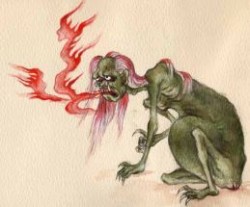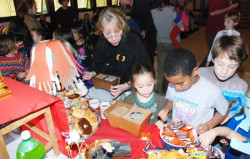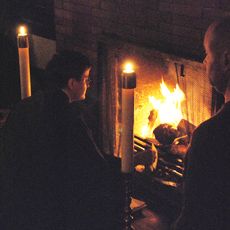On Segaki
From our Archives – an article printed years ago, and used as a handout – By Kyogen Carlson
Next to Jukai, which comes every spring, Segaki is the most important festival on our calendar. The name “Segaki” means “feeding the hungry ghosts,” and the rituals and practices done for this festival contain a great deal of teaching about training in Buddhism. On one hand Segaki is a time for remembering the dead and resolving our karmic connections with those who have died, but it is also a time for resolving our own internal karmic  difficulties and for letting go of the obstacles and blockages we carry around with us. The festival is said to have begun when Moggallana, a disciple of the Buddha, was plagued by dreams of his recently departed mother suffering in a world in which she could neither eat nor drink. Food would turn to fire, and water would turn to blood or pus whenever it touched her mouth. Moggallana went to the Buddha and told him of his dreams, which tormented him every night. The Buddha explained that Moggallana was seeing the suffering of his mother in the world of the gakis (pretas in Sanskrit), or hungry ghosts. Gakis are usually depicted as having long skinny necks, with throats much too small for swallowing, and the bloated, bulging stomachs common with severe malnutrition. This imagery is a fantastic description of a spiritual state which can be seen every day, right here in the world of living women and men. It is a condition which everyone suffers from, to one degree or another, at some point in life. On the most spiritual level, this is the state of someone who desperately wants to know the Truth, but who cannot accept the teaching. He knows he is suffering and that religious practice can be of help, but he just cannot stop resisting and holding on to his personal opinions. Wanting the Dharma, he goes to drink, but his throat will not open to accept it. Each time he tastes the teaching it turns to fire in his mouth. On the everyday level, this condition is that of someone who has desperate needs, but like a woman with a phantom itch, can find no relief. Women who frantically cling to their children long after they are grown, and men who cannot get enough wealth and success, are everyday examples of hungry ghosts. In examples such as these, the problem lies in trying to satisfy an inner need for wisdom, equanimity, or peace of mind through grasping after external things, instead of cultivating empty handed all-acceptance, which is the real solution. How often our attempts to obtain the things we want are like this.
difficulties and for letting go of the obstacles and blockages we carry around with us. The festival is said to have begun when Moggallana, a disciple of the Buddha, was plagued by dreams of his recently departed mother suffering in a world in which she could neither eat nor drink. Food would turn to fire, and water would turn to blood or pus whenever it touched her mouth. Moggallana went to the Buddha and told him of his dreams, which tormented him every night. The Buddha explained that Moggallana was seeing the suffering of his mother in the world of the gakis (pretas in Sanskrit), or hungry ghosts. Gakis are usually depicted as having long skinny necks, with throats much too small for swallowing, and the bloated, bulging stomachs common with severe malnutrition. This imagery is a fantastic description of a spiritual state which can be seen every day, right here in the world of living women and men. It is a condition which everyone suffers from, to one degree or another, at some point in life. On the most spiritual level, this is the state of someone who desperately wants to know the Truth, but who cannot accept the teaching. He knows he is suffering and that religious practice can be of help, but he just cannot stop resisting and holding on to his personal opinions. Wanting the Dharma, he goes to drink, but his throat will not open to accept it. Each time he tastes the teaching it turns to fire in his mouth. On the everyday level, this condition is that of someone who has desperate needs, but like a woman with a phantom itch, can find no relief. Women who frantically cling to their children long after they are grown, and men who cannot get enough wealth and success, are everyday examples of hungry ghosts. In examples such as these, the problem lies in trying to satisfy an inner need for wisdom, equanimity, or peace of mind through grasping after external things, instead of cultivating empty handed all-acceptance, which is the real solution. How often our attempts to obtain the things we want are like this.
Moggallana’s dreams were due to his deep connection with his mother, and the Buddha’s advice to him was that he should make an offering to her of whatever food she could most easily accept and digest. This was to be done in a ceremony, dedicated in her name, at the time when the monks conducted their regular gathering to confess their transgressions. This part of the story shows profound wisdom and upaya, skillful means, and reveals the correlation between making offerings to the dead and the cleansing of karma; both personal karma and karma connected to someone who has died. Linking the offering for the deceased mother to the time of confession, the Buddha built a bridge for Moggallana to the mind of repentance and forgiveness, helping him let go of his own entanglements. One way we might understand Moggallana and his mother in modern terms to say they were “enmeshed,” unable to untangle their mutual attachments. An offering made at the time of the monks’ ceremonial confession and letting go could be powerfully healing.
 Today, the tradition that started with this ceremony is continued every year in Buddhist temples by making an offering on a table far away from any statue or picture of a Buddha or Bodhisattva. For those who reject religious teaching, kindness is offered without doctrine as the truest form of generosity. For an offering to be genuinely one of Dharma, it can only be given in forms that can be accepted and really made use of. Offerings of any type made in such a manner will naturally benefit both the recipient and the donor. This principle applies to so many situations we encounter in everyday life, and such an action naturally expresses all-acceptance in a way that touches and deeply effects all concerned.
Today, the tradition that started with this ceremony is continued every year in Buddhist temples by making an offering on a table far away from any statue or picture of a Buddha or Bodhisattva. For those who reject religious teaching, kindness is offered without doctrine as the truest form of generosity. For an offering to be genuinely one of Dharma, it can only be given in forms that can be accepted and really made use of. Offerings of any type made in such a manner will naturally benefit both the recipient and the donor. This principle applies to so many situations we encounter in everyday life, and such an action naturally expresses all-acceptance in a way that touches and deeply effects all concerned.
Chin Sin Peh, a Buddhist of Chinese extraction from Singapore, was a visitor to the Zen Center a number of years ago. The topic of Segaki came up, and he told us something of how this festival is celebrated in China. According to popular Chinese legend, Moggallana was accomplished in supernatural arts, and developed a deep resolve to help his mother when he saw her suffering in his visions. He traveled down to hell to try to rescue her personally. He broke the lock on the gate to hell, and because of this, all the hungry ghosts in the realm of the gakis got loose, and wandered about in the human world. The festival was then done to satisfy the ghosts, and to convince them to return to where they needed to be. Some, through the festival, gained release. This popular view of it expresses that even those who did not gain release were in the process of learning something they needed to understand, and the place for that was the hell where they found rebirth; but their time to advance to something else would come eventually too.
In China, the seventh lunar month is the month of the dead. Nowadays, during this festival, many Chinese believe all the ghosts are released from hell for the entire month; like a great vacation. During this time, people pay respects to all their ancestors and make offerings to them, particularly of food. They also make offerings of entertainment, like Chinese opera, puppet shows, spectacles, and circuses; anything people think the ghosts might enjoy. The entire month becomes a huge celebration, and a time of great happiness when people feel very close to their ancestors; whether they happen to be in the realm of the gakis, or elsewhere. This quality of celebration is the same as the offering of dancing and joyous music done at Obon in Japan. Rather than being grim or solemn, the whole affair is very joyous, even raucous. In China, popular legend also has it that after giving aid to his mother, Moggallana made a vow to once again enter hell. He vowed to do his own practice there for the sake of those suffering in that realm. “If I do not do so, who else will?” he said. He became a Bodhisattva, an “enlightenment being” dedicated to helping others before enjoying final enlightenment himself, offering Dharma to all those suffering in the nether worlds. To this day he is venerated for this act of great compassion.
So gakis, hungry ghosts, are not the only ones to be remembered at Segaki. It is a time to remember all those who have died, to be thankful for their having lived, and to give thanks for the teaching their lives give to us. It is also a time to let go of those who have died, to realize that their practice goes on in whatever form it now takes, and that they do not need us pulling them back to this world through our attachments. By letting go of those who are now gone, we can also resolve the painful memories that sometimes linger to become the nucleus for a multitude of other problems. All-acceptance is really the key, for if we completely accept those who have died as they were, we can understand them better and offer them what they need to go on, which is, quite often, our forgiveness and blessing.
 If you apply this process to yourself, looking at your own past actions as that which must be released, it is easy to see the connection between Segaki and personal karmic cleansing. After all, the self of the past can become a ghost in the present which needs the Dharma too. Looked at this way, Segaki is a time of deep, personal, spiritual renewal. Here at Dharma Rain Zen Center, the main Segaki ceremony, which is done in the morning, features an altar laden with food. The ceremony involves an invitation to all ghosts of every stripe anywhere to come join us, in effect asking all the unhappy, unresolved karma in the universe to come to the altar to receive the Dharma in the form of food. During the chanting and procession we offer incense and the names of people who have died in the past year are read. After the ceremony we help the gakis by eating the food on the altar ourselves! Next, a live gaki visits the Dharma School Children; this annual visit always brings joy (and a bit of
If you apply this process to yourself, looking at your own past actions as that which must be released, it is easy to see the connection between Segaki and personal karmic cleansing. After all, the self of the past can become a ghost in the present which needs the Dharma too. Looked at this way, Segaki is a time of deep, personal, spiritual renewal. Here at Dharma Rain Zen Center, the main Segaki ceremony, which is done in the morning, features an altar laden with food. The ceremony involves an invitation to all ghosts of every stripe anywhere to come join us, in effect asking all the unhappy, unresolved karma in the universe to come to the altar to receive the Dharma in the form of food. During the chanting and procession we offer incense and the names of people who have died in the past year are read. After the ceremony we help the gakis by eating the food on the altar ourselves! Next, a live gaki visits the Dharma School Children; this annual visit always brings joy (and a bit of  apprehension) to the little ones, who must teach the ill-mannered gaki the way to behave in a temple, and a little of the Dharma if possible. The closing ceremony, Segaki Toro, is done in the evening. It is an intense, symbolic ritual of cleansing. During the ceremony a fire is lit in the fireplace, and slips of paper with the names of people who have died in the past year, along with the year’s transfer of merit cards, are fed to the fire. Anyone who wishes can write down some karma or problem that they wish to let go of or cleanse, and one-by-one, they put them on the fire themselves.
apprehension) to the little ones, who must teach the ill-mannered gaki the way to behave in a temple, and a little of the Dharma if possible. The closing ceremony, Segaki Toro, is done in the evening. It is an intense, symbolic ritual of cleansing. During the ceremony a fire is lit in the fireplace, and slips of paper with the names of people who have died in the past year, along with the year’s transfer of merit cards, are fed to the fire. Anyone who wishes can write down some karma or problem that they wish to let go of or cleanse, and one-by-one, they put them on the fire themselves.
The themes of death, change, and spiritual transition have for centuries in the West been remembered in the autumn, at the time of change from light to dark, from heat to cold. In adapting Buddhist traditions to our culture, Dharma Rain Zen Center celebrates Segaki on or near Halloween or All Souls Day, when all the ghosts and goblins from the past come out of hiding. What better time to offer them merit and put them back to rest? The Segaki festival is sometimes observed with a week-long Meditation Vigil, and always a weekend Retreat, and the traditional Segaki Ceremonies.
This year the Segaki retreat is from Friday evening October 25 through Sunday evening October 27. For details see the Segaki Description.
